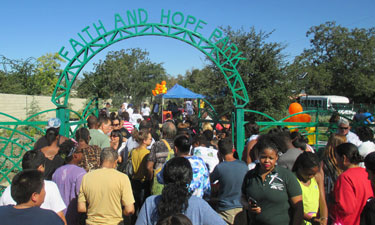 Across the United States, voters regularly pass multi-million-dollar environmental funding measures at the state and local level. During the past three decades, voters have approved 1,703 measures providing $164 billion in funding for land conservation — including parks and recreation facilities — in 45 out of 50 states.
Across the United States, voters regularly pass multi-million-dollar environmental funding measures at the state and local level. During the past three decades, voters have approved 1,703 measures providing $164 billion in funding for land conservation — including parks and recreation facilities — in 45 out of 50 states.
Yet, we rarely if ever look back at who has benefited from all that spending.
What if we did look back and learn? Could we then make smarter investments in the future?
At UCLA’s Institute of the Environment and Sustainability, we did a first-of-its-kind, systematic analysis of spending under the last major environmental bond approved by California voters in 2006. Proposition 84 authorized $5.4 billion to improve parks, natural resource protection and water quality, safety and supply across the state. Most of that money has now been spent. And, for the first time ever, we have good enough data to ask some crucial questions.
Where was that funding spent? Who benefited? And, were funds spent according to priorities stated in the measure approved by voters?
While our study only covered one bond measure in one state, we hope that we will be able to do more studies like this in California and in other states, as open data reporting requirements continue to improve and spread throughout the country.
Our study analyzed $2 billion of Prop. 84 funding spent on 2,174 projects with identifiable local impacts in California communities. We found decidedly mixed results. Our study was not an audit of individual projects. Nor did we examine purely environmental benefits. We looked at benefits for people and communities, and we found that when those priorities were clearly spelled out, funds were spent according to those priorities. But, when priorities were left vague, spending was not closely aligned with those priorities.
Overall, although “local parks and urban greening” were listed as priorities for Prop. 84, we found that communities that lack parks received less funding than those that already have parks.
We found that rural areas, with lower population density, received just as much funding as urban areas. Residents in rural areas within a half-mile walking distance of funded projects saw $7,475 per capita in spending in their neighborhoods, while residents in urban areas saw only $209 in per-capita spending.
And, we found that less funding was spent in disadvantaged communities, which were prioritized in several sections of the proposition, than was spent in communities with higher median household income.
There was a bright spot in Prop. 84: $400 million was set aside for competitive grants administered by the California Department of Parks and Recreation for “underserved communities” to create “parks in neighborhoods where none currently exist.” The criteria and process for selecting projects were carefully spelled out in a separate law: AB 31, the Statewide Park Development and Community Revitalization Act of 2008, sponsored by Sen. Kevin de León (D-CA-24), then assembly member, now president pro tem of the California State Senate.
That worked. The money went to the priorities approved by voters.
Looking ahead, a $3 billion parks bond sponsored by assembly member Eduardo Garcia could be on the statewide ballot in California this fall. Sen. de León is also working on a bill. Garcia’s bill incorporates some of the lessons of Prop. 84 — a third of the money would be administered under AB 31, and a good portion of the funding would be distributed proportional to population.
That’s a good start. People need to be put into the equation for environmental bond spending, but it could go further.
More of the funding could be explicitly prioritized for disadvantaged communities that have not historically seen the benefits of spending on parks — proportional to their population, at least, if not more because of their greater need.
There should also be more explicit articulation of priorities and criteria for every section of funding — not just for parks, but also for other conservation and natural resource protection projects.
And explicit requirements for better data reporting need to be written into law so that we can look back at how our money was spent and learn how to do even better in the future.
The same thing could be said about the 1,702 other similar funding measures passed around the country during the past three decades, and, more importantly, measures on the ballot this year. At least $1.4 billion is already at stake on upcoming ballots in California, Florida, Massachusetts, Michigan and New Jersey.
But the real opportunity is to get this right on parks and recreation funding measures that have not yet been finalized in cities, counties and states nationwide. The key is in the careful writing of ballot measures to include clear priorities, explicit criteria and data-reporting requirements. Results will follow.
View the full report and an interactive view of the data.
Jon Christensen is an Adjunct Assistant Professor at the Institute of the Environment and Sustainability at UCLA.

